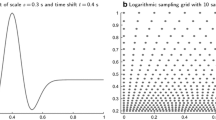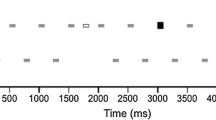Abstract
In the search for the biomarkers of schizophrenia, event-related potential (ERP) deficits obtained by applying the classic oddball paradigm are among the most consistent findings. However, the single-subject classification rate based on these parameters remains to be determined. Here, we present a data-driven approach by applying machine learning classifiers to relevant oddball ERPs. Twenty-four schizophrenic patients and 24 matched healthy controls finished auditory and visual oddball tasks while high-density electrophysiological recordings were applied. The N1 component in response to standards and target as well as the P3 component following targets were submitted to different machine learning algorithms and the resulting ERP features were submitted to further correlation analyses. We obtained a classification accuracy of 72.4 % using only two ERP components. Latencies of parietal N1 components to visual standard stimuli at electrode positions Pz and P1 were sufficient for classification. Further analysis revealed a high correlation of these features in controls and an intermediate correlation in schizophrenia patients. These data exemplarily show how automated inference may be applied to classify a pathological state in single subjects without prior knowledge of their diagnoses and illustrate the potential of machine learning algorithms for the identification of potential biomarkers. Moreover, this approach assesses the discriminative accuracy of one of the most consistent findings in schizophrenia research by means of single-subject classification.


Similar content being viewed by others
References
Sponheim SR, Iacono WG, Thuras PD, Beiser M (2001) Using biological indices to classify schizophrenia and other psychotic disorders. Schizophr Res 50:139–150
Carter JW, Schulsinger F, Parnas J, Cannon T, Mednick SA (2002) A multivariate prediction model of schizophrenia. Schizophr Bull 28:649–682
Braff DL (1993) Information processing and attention dysfunctions in schizophrenia. Schizophr Bull 19:233–259
Turetsky BI, Colbath EA, Gur RE (1998) P300 subcomponent abnormalities in schizophrenia: II. Longitudinal stability and relationship to symptom change. Biol Psychiatry 43:31–39
Bramon E, Rabe-Hesketh S, Sham P, Murray RM, Frangou S (2004) Meta-analysis of the P300 and P50 waveforms in schizophrenia. Schizophr Res 70:315–329
Polich J, Ladish C, Bloom FE (1990) P300 assessment of early Alzheimer’s disease. Electroencephalogr Clin Neurophysiol 77:179–189
Hesselbrock V, Begleiter H, Porjesz B, O’Connor S, Bauer L (2001) P300 event-related potential amplitude as an endophenotype of alcoholism-evidence from the collaborative study on the genetics of alcoholism. J Biomed Sci 8:77–82
Gangadhar BN, Ancy J, Janakiramaiah N, Umapathy C (1993) P300 amplitude in non-bipolar, melancholic depression. J Affect Disord 28:57–60
Salisbury DF, Shenton ME, McCarley RW (1999) P300 topography differs in schizophrenia and manic psychosis. Biol Psychiatry 45:98–106
Butler PD, Martinez A, Foxe JJ, Kim D, Zemon V, Silipo G, Mahoney J, Shpaner M, Jalbrzikowski M, Javitt DC (2007) Subcortical visual dysfunction in schizophrenia drives secondary cortical impairments. Brain 130:417–430
Haenschel C, Bittner RA, Haertling F, Rotarska-Jagiela A, Maurer K, Singer W, Linden DEJ (2007) Contribution of impaired early-stage visual processing to working memory dysfunction in adolescents with schizophrenia: a study with event-related potentials and functional magnetic resonance imaging. Arch Gen Psychiatry 64:1229–1240
Yeap S, Kelly SP, Sehatpour P, Magno E, Javitt DC, Garavan H, Thakore JH, Foxe JJ (2006) Early visual deficits as endophenotypes for schizophrenia: high-density electrical mapping in clinically unaffected first-degree relatives. Arch Gen Psychiatry 63:1180–1188
First MB, Spitzer RL, Gibbon M, Williams JBW (2001) Structured clinical interview for DSM-IV-TR axis I disorders—non-patient edition. New York State Psychiatric Institute, New York
Jung TP, Makeig S, Westerfield M, Townsend J, Courchesne E, Sejnowski TJ (2000) Removal of eye activity artifacts from visual event-related potentials in normal and clinical subjects. Clin Neurophysiol 111:1745–1758
Guyon I, Gunn S, Nikravesh M, Zadeh LA (2006) Feature extraction: foundations and applications. Springer, Berlin
Benjamini Y, Yekutieli D (2001) The control of false discovery rate in multiple testing under dependency. Ann Stat 29:1165–1188
Mahalanobis PC (1936) On the generalised distance in statistics. Proc Natl Inst Sci India 2:49–55
Vapnik VN (1998) Statistical learning theory. Wiley, New York
Sehatpour P, Dias EC, Butler PD, Revheim N, Guilfoyle DN, Foxe JJ, Javitt D (2010) Impaired visual object processing across an occipital-frontal-hippocampal brain network in schizophrenia. Arch Gen Psychiatry 67:772–782
Turetsky BI, Greenwood TA, Olincy A, Radant AD, Braff DL, Cadenhead KS, Dobie DJ, Freedman R, Green MF, Gur RE, Gur RC, Light GA, Mintz J, Nuechterlein KH, Schork NJ, Seidman LJ, Siever LJ, Silverman JM, Stone WS, Swerdlow NR, Tsuang DW, Tsuang MT, Calkins ME (2008) Abnormal auditory N100 amplitude: a heritable endophenotype in first-degree relatives of schizophrenia probands. Biol Psychiatry 64:1051–1059
Mulert C, Gallinat J, Pascual-Marqui R, Dorn H, Frick K, Schlattmann P, Mientus S, Herrmann WM, Winterer G (2001) Reduced event-related current density in the anterior cingulate cortex in schizophrenia. Neuroimage 13:589–600
Iyer D, Zouridakis G (2008) Single-trial analysis of the auditory N100 improves separation of normal and schizophrenic subjects. In: Proceedings of the 30th annual international IEEE EMBS conference, Vancouver, British Columbia, Canada, 20–24 Aug, pp 3840–3843
Neuhaus AH, Popescu F, Grozea C, Urbanek C, Hahn E, Hahn C, Opgen-Rhein C, Urbanek C, Dettling M (2011) Single-subject classification of schizophrenia by event-related potentials during selective attention. Neuroimage 55:514–521
Winterer G, Ziller M, Dorn H, Frick K, Mulert C, Wuebben Y, Herrmann WM (2000) Frontal dysfunction in schizophrenia—a new electrophysiological classifier for research and clinical applications. Eur Arch Psychiatry Clin Neurosci 250:207–214
Zilles D, Gruber E, Falkai P, Gruber O (2011) Patients with schizophrenia show deficits of working memory maintenance components in circuit-specific tasks. Eur Arch Psychiatry Clin Neurosci 260:519–525
Montag C, Neuhaus K, Lehmann A, Krueger K, Dziobek I, Heekeren HR, Heinz A, Gallinat J (2012) Subtle deficits of theory of mind in unaffected first-degree relatives of schizophrenia patients. Eur Arch Psychiatry Clin Neurosci 262:217–262
Haker H, Rössler W (2009) Empathy in schizophrenia: impaired resonance. Eur Arch Psychiatry Clin Neurosci 259:352–361
Derntl B, Habel U (2011) Deficits in social cognition: a marker for psychiatric disorders? Eur Arch Psychiatry Clin Neurosci 261:S145–S149
Caan MWA, Vermeer KA, van Vliet LJ, Majoie CBLM, Peters BD, den Heeten GJ, Vos FM (2006) Shaving diffusion tensor images in discriminant analysis: a study into schizophrenia. Med Image Anal 10:841–849
Takayanagi Y, Kawasaki Y, Nakamura K, Takahashi T, Orikabe L, Toyoda E, Mozue Y, Sato Y, Itokawa M, Yamasue H, Kasai K, Kurachi M, Okazaki Y, Matsushita M, Suzuki M (2010) Differentiation of first-episode schizophrenia patients from healthy controls using ROI-based multiple structural brain variables. Progr Neuropsychopharmacol Biol Psychiatry 34:10–17
Davatzikos C, Shen D, Gur RC, Wu X, Liu D, Fan Y, Hughett P, Turetsky BI, Gur RE (2005) Whole-brain morphometric study of schizophrenia revealing a spatially complex set of focal abnormalities. Arch Gen Psychiatry 62:1218–1227
Pardo PJ, Georgopoulos AP, Kenny JT, Stuve TA, Findling RL, Schulz SC (2006) Classification of adolescent psychotic disorders using linear discriminant analysis. Schizophr Res 87:297–306
Kawasaki Y, Suzuki M, Kherif F, Takahashi T, Zhou SY, Nakamura K, Matsui M, Sumiyoshi T, Seto H, Kurachi M (2007) Multivariate voxel-based morphometry successfully differentiates schizophrenia patients from healthy controls. Neuroimage 34:235–242
Yoon U, Lee JM, Im K, Shin YW, Cho BH, Kim IY, Kwon JS, Kim SI (2007) Pattern classification using principal components of cortical thickness and its discriminative pattern in schizophrenia. Neuroimage 34:1405–1415
Cecchi G, Rish I, Thyreau B, Thirion B, Plaze M, Paillerre-Martinot ML, Martelli C, Martinot JL, Poline JB (2009) Discriminative network models of schizophrenia. In: Bengio Y, Schuurmans D, Lafferty J, Williams CKI, Culotta A (eds) Advances in neural information processing systems. Proceedings of the 22th NIPS conference, Vancouver, British Columbia, Canada, 7–10 Dec. Available online at http://books.nips.cc/nips22.html
Castro E, Martinez-Ramon M, Pearlson G, Sui J, Calhoun VD (2011) Characterization of groups using composite kernels and multi-source fMRI analysis data: application to schizophrenia. Neuroimage 58:526–536
Ardekani BA, Tabesh A, Sevy S, Robinson DG, Bilder RM, Szeszko PR (2011) Diffusion tensor imaging reliably differentiates patients with schizophrenia from healthy volunteers. Hum Brain Mapp 32:1–9
Lanterman AD (2001) Schwarz, Wallace, and Rissanen: intertwining themes in theories of model selection. Int Stat Rev 69:185–212
Conflict of interest
None.
Author information
Authors and Affiliations
Corresponding author
Rights and permissions
About this article
Cite this article
Neuhaus, A.H., Popescu, F.C., Bates, J.A. et al. Single-subject classification of schizophrenia using event-related potentials obtained during auditory and visual oddball paradigms. Eur Arch Psychiatry Clin Neurosci 263, 241–247 (2013). https://doi.org/10.1007/s00406-012-0326-7
Received:
Accepted:
Published:
Issue Date:
DOI: https://doi.org/10.1007/s00406-012-0326-7




